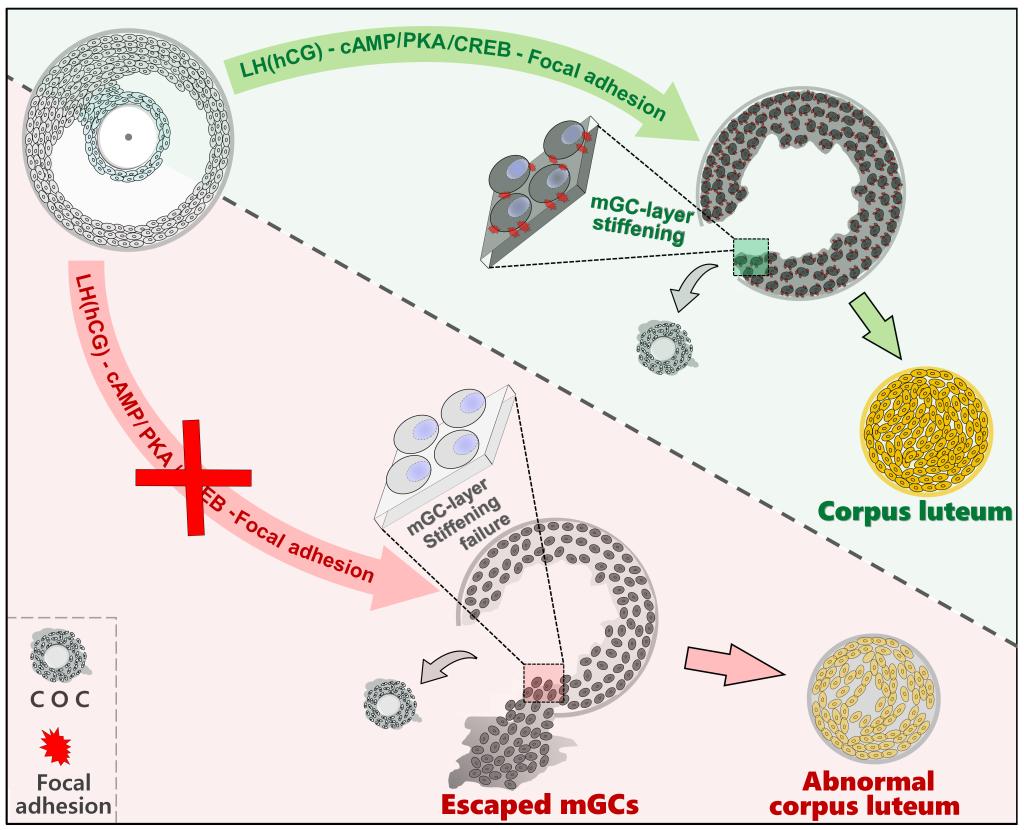(通讯员 施泓如)近日,我院动物繁殖研究团队在国际期刊Advanced Science上发表了题为“Granulosacell-layer stiffening prevents escape of mural granulosa cells from the post-ovulatory follicle”的研究论文。该研究提出了“壁颗粒细胞层硬化(mGC-layer stiffening)”的新概念,并对其在排卵与黄体形成中的作用进行了深入研究。
卵泡是卵巢的功能单元,其本质是一个由壁颗粒细胞、卵丘细胞以及卵母细胞等细胞类型所构成的复合结构。排卵后,这些原本聚集在一起的细胞却要经历截然不同的命运。其中,卵丘细胞发生扩张,陪同卵母细胞一起离开破裂的卵泡,转移至输卵管中完成受精。与卵丘细胞不同,壁颗粒细胞则被继续滞留在破裂的卵泡中,转化为维持妊娠的黄体。
有趣的是,卵丘细胞和壁颗粒细胞在起源上是相同的,它们均是由腔前卵泡中共同前体细胞分化而来。那么,为何卵丘细胞能在排卵后脱离破裂的卵泡,而拥有相同细胞起源的壁颗粒细胞却不能呢?或者说,是什么机制将壁颗粒细胞阻滞在破裂的卵泡中?目前为止,这个令人困惑的繁殖学问题尚无明确答案。
团队以小鼠和山羊为研究对象,通过体内、外试验证实壁颗粒细胞层在排卵阶段会经历一个被称为“硬化(mGC-layer stiffening)”的过程。这个“硬化”所带来的直接后果是让整个壁颗粒细胞层发展成为一个拥有较强机械刚性的整体,从而得以在卵泡破裂时“卡”在卵泡残腔中,无法从细小的排卵点逃离出来。相反,无论是利用基因沉默手段还是药物阻断“mGC-layer stiffening”,都会导致大量壁颗粒细胞从破裂的卵泡中释放出来,形成一个细胞稀少和空腔化的黄体。利用组学手段和验证性实验,团队进一步证实排卵信号所促发的黏着斑组装是导致“mGC-layer stiffening”的直接原因,并阐明了cAMP-PKA-CREB是排卵信号促发黏着斑组装和“mGC-layer stiffening”的关键信号级联(图1)。

排卵信号触发的“mGC-layer stiffening”阻止壁颗粒细胞逃离破裂卵泡示意图
同行评审就研究创新性给出了Top 5%的评价:“This manuscript investigates an issue that has rarely been considered in reproductivebiology ......,this is a highly novel, well-organized, and nicely supported study that would be of interest to a wide range of reproductive biologists...”.总的来说,这项研究提出了“mGC-layer stiffening”新概念,合理解释了“壁颗粒细胞无法在排卵后逃离破裂卵泡”这一繁殖学现象。这是继提出“坝-泵-管道”模型解释卵泡期成因后(J Biol Chem., 2023),团队在卵泡发育研究中取得的又一进展,丰富了繁殖调控理论体系。动物繁殖与特经系何长久为论文通讯作者,李翔副教授、中国农大刘国世教授和吴昊博士参与了研究。毕业硕士王晓东,在读研究生廖建宁与施泓如为论文共同一作;研究生赵永恒与柯文凯也参与了试验。该研究由中央高校基本科研资金、国自然基金、湖北省家畜种业创新项目资助。
英文摘要:Ovulation is vital for successful reproduction. Following ovulation, cumulus cells and oocyte are released, while mural granulosa cells (mGCs) remain sequestered within the post-ovulatory follicle to form the corpus luteum. However, the mechanism underlying the confinement of mGCs has been a longstanding mystery. Here, in vitro and in vivo evidence is provided demonstrating that the stiffening of mGC-layer serves as an evolutionarily conserved mechanism that prevents mGCs from escaping the post-ovulatory follicles. The results from spatial transcriptome analysis and experiments reveal that focal adhesion assembly, triggered by the LH (hCG)-cAMP-PKA-CREB signaling cascade, is necessary for mGC-layer stiffening. Disrupting focal adhesion assembly through RNA interference results in stiffening failure, mGC escape, and the subsequent development of an abnormal corpus luteum characterized by decreased cell density or cavities. These findings introduce a novel concept of “mGC-layer stiffening”, shedding light on the mechanism that prevents mGC escape from the post-ovulatory follicle.
审核人:何长久
相关论文链接:
https://onlinelibrary.wiley.com/doi/10.1002/advs.202403640
https://www.sciencedirect.com/science/article/pii/S0021925823020434?via%3Dihub

